Why Are Tides So Tiny In Hawaii And Enormous In Europe?
Surely we’re not the only ones who have wondered about this.
I do not understand tides.
As a surfer of 20-odd years, this is an embarrassing admission to make, but it’s safe to assume that this particular ignorance is not mine alone.
To be clear, I understand that tides are caused by the gravitational pull of the moon (and the sun—more on this below), and that in most places around the world, there are two high tides and two low tides per day.
However, one of the things I’ve always struggled to comprehend is why some surf spots can fire all day long with negligible tide swings (e.g., Hawaii, where tides typically vary less than a meter), while other spots have shorter windows of quality surf due to rapid tidal changes (e.g., Europe, where tides can vary 7-13 meters).
So, I did some research.
Looking at a world map of tides (see here), I was surprised to find that there was no apparent correlation between longitude or latitude and the size of the tidal range.
Perplexed, I dug deeper into some of Wikipedia’s more scientific passages, where the words became increasingly larger and my comprehension of them proportionately smaller.
Rather than stumble over syllables all day, I decided to enlist the help of an expert who could help translate these complex ideas into more simple terms.
Enter Dr. Kai Hally-Rosendahl, a man with a Ph.D. in physical oceanography.
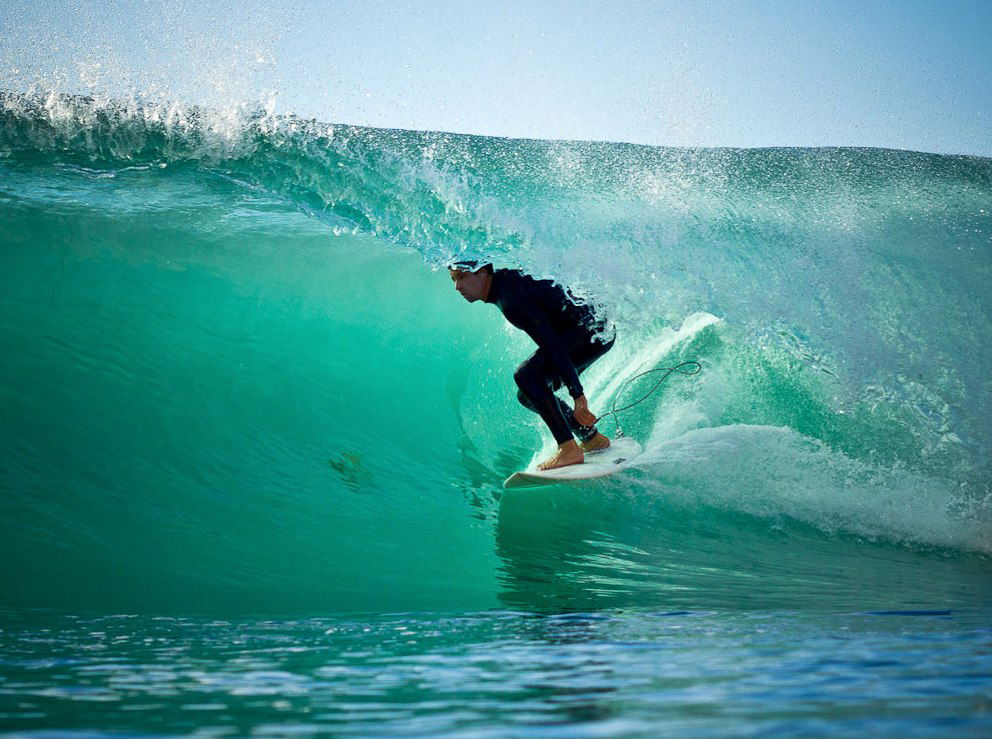
Dr. Kai is not only an ocean expert by degree—he’s also a talented tube excavator. Photo: Marcio Canavarro
I met Kai during my years in San Diego, where on the best winter days, he would surf a particularly wedgy beach break from dawn to dusk. That’s 12 hours in the water with no breaks—just a Clif Bar stuffed up his wetsuit sleeve for midday sustenance.
Pairing his hands-on knowledge with over a decade of physical oceanography study, Kai was the ideal source for answering my questions regarding tidal range disparities around the globe.
Over the course of a 30-minute phone call, Kai explained—in terms as simple as possible while keeping true to the science—why tide swings are massive in some places and tiny in others. It turns out that the reasons behind this phenomenon are both vast and intricate, so Kai focused on the three primary factors: coastline shape, continental shelf configuration, and proximity to “amphidromic points”.
In addition to heavily simplifying the science, Kai explained the tidal effects of each factor individually, assuming the other factors were being held constant. But it’s important to remember that a combination of all of these factors (plus others not discussed here) ultimately determine the tidal range at a given surf spot.
If even a simplified take on this surf-related science isn’t quite your jam, go ahead and watch the first 4 or so minutes of the Neil deGrasse Tyson video below, and then scroll to the TLDR version of the text towards the end.
For those interested in a more thorough story of tides, I’ll do my best to summarize Dr. Kai’s explanations below.
Fundamentals of tides:
Many people—myself included, until just recently—have an incorrect understanding of basic tidal movement.
First of all, the Earth’s tides are caused by the gravitational pull of both the moon and the sun. Despite being significantly smaller in size, the moon’s proximity to Earth means that it influences the tide roughly two times as much as the sun. Many of you may already know these basics.
However, contrary to popular belief, the tide doesn’t really come “in and out”. Rather, the sun and the moon each create two “bulges” of water—both on the side of the Earth closest to their gravitational pull and on the side opposite to it. These bulges are more or less locked to the position of the sun and the moon, while our Earth rotates beneath them.
So when we see that the tide is “rising”, what’s actually happening is our region of the Earth is rotating into a bulge, and when the tide is “dropping”, we’re rotating out of it.
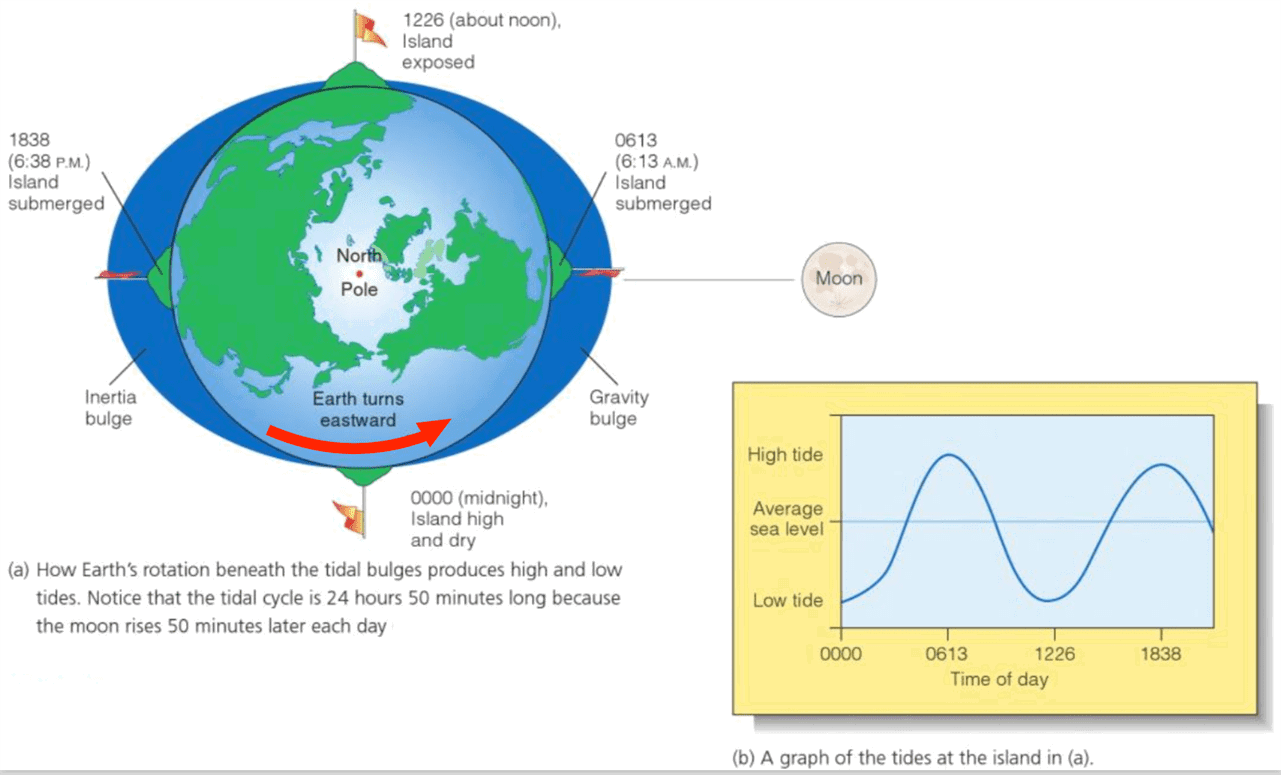
Earth’s rotation beneath somewhat static ocean bulges is what causes the relative movement of the tides. Figure: Tom Garrison, 2014
Perhaps the most familiar tidal phenomenon for many of us is the larger tidal swings during full and new moons (“spring” tides) and the smaller tidal swings during quarter moons (“neap” tides). Spring tides occur when the sun, moon, and Earth are in alignment, and the sun’s bulges add to the moon’s bulges. In contrast, neap tides occur when the sun, moon, and Earth form a right angle, and the sun’s bulges effectively diminish the moon’s bulges.
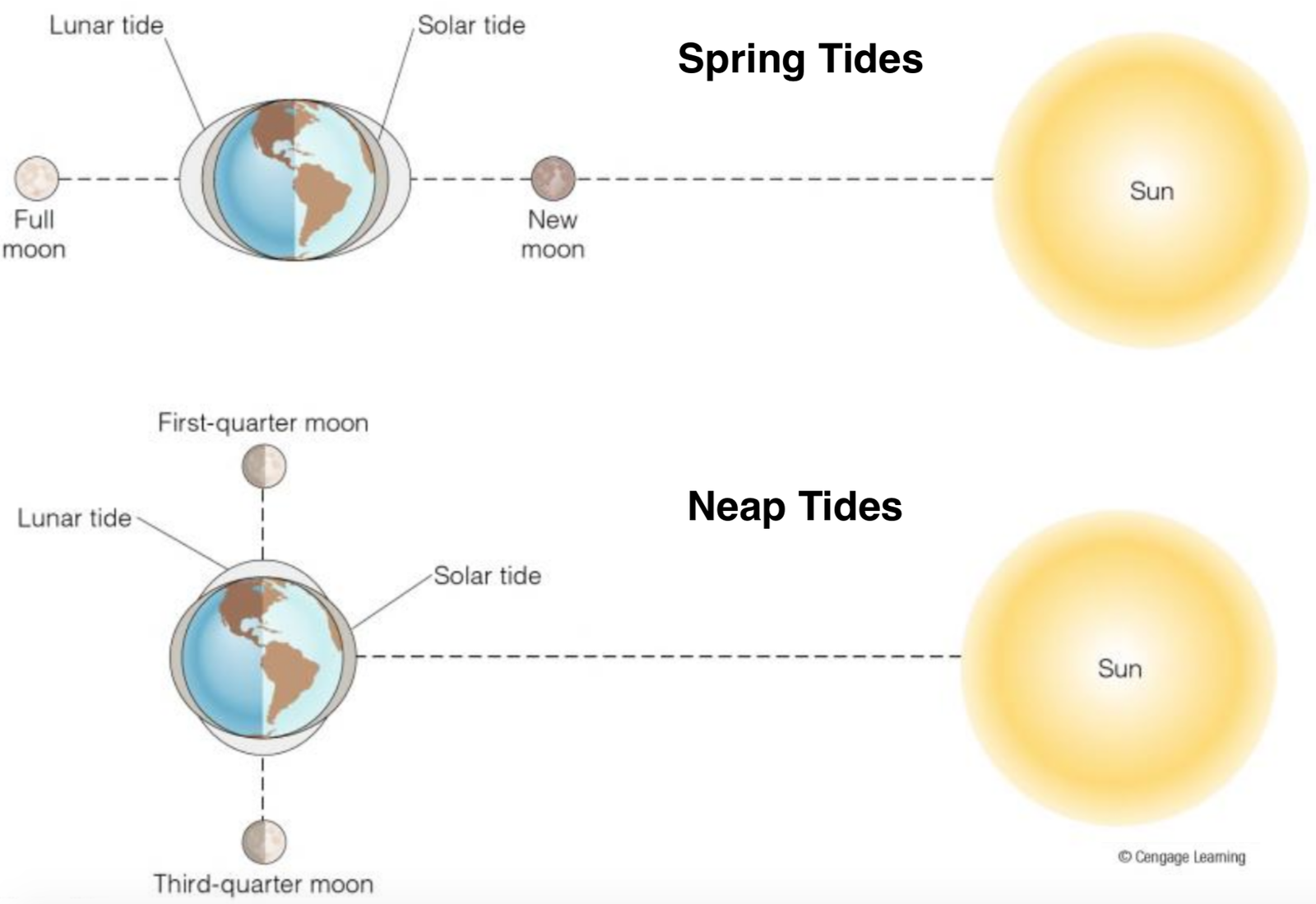
Higher spring tides during full and new moons result from the alignment of the Earth-moon-sun system (If these things are confusing, check out the animated explanations in the first few minutes of this Neil deGrasse Tyson video above). Figure: Tom Garrison, 2014
Those are the basics of how tides would behave and move around the Earth if it were completely covered with water and had no landmasses. But having no land would be boring—we’d have no waves to surf.
And, not only do the landmasses give us surfable waves, they also make the tidal story quite a bit more interesting.
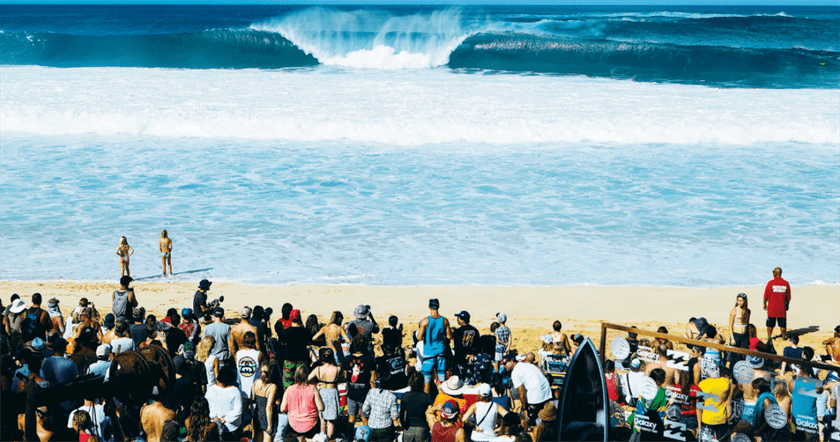
Wondering how Pipeline can be good all day long? The small tide swings certainly help. All-day offshores don’t hurt either. Photo: WSL
Shape of the coastline:
Out in the open ocean, the tidal bulges are generally less than a meter. But when the bulges are pulled towards land, they have the potential to grow in height, leading to larger tidal swings.
Simply put, coastlines with more curves (bays, coves, etc.) will tend to have larger tidal swings than straighter, less varied coastlines.
When a tidal bulge approaches a coastline that is confined by a bay, the reduction of available space for the tidal bulge to fill tends to cause a funneling effect (perhaps the term “conservation of mass” rings a bell). This results in a greater increase in tidal height than if that same bulge wasn’t constricted by a bay.
“But bays can do more than just funnel the water to increase the tidal range. Certain bays with specific sizes and shapes that have ‘natural oscillation periods’ close to the periods of the tides themselves—roughly 12 or 24 hours—can experience tidal ‘resonance’. This causes an amplification of the tidal energy, resulting in heights being much greater than the incoming bulge. The most famous example is probably the Bay of Fundy in Nova Scotia, where you can see tide swings up to 15 meters,” said Kai.
Similar resonance phenomena, in part, explain why Europe’s big Bay of Biscay has some of the largest tides in the surfing world—occasionally over 13 meters between highs and lows.
This phenomenon of “resonance” contributes to the enormous tide swings we see at some spots around theglobe. The main takeaways are covered in the first 2:55 minutes.
Continental shelf configuration:
Another thing that can make the tidal bulges grow is a continental shelf off the coast. In the most simplified terms—the shallower the depth of the shelf, the bigger the tidal swings.
When I first heard this, I found it contrary to logic. In my mind, a deeper ocean near the coast would allow for larger tide swings, because there was more water in the nearshore region to be displaced.
Correcting this misconception took a lot of explaining on Kai’s end, but finally it clicked:
“Tides are actually waves. They’re fundamentally different than the types of waves we surf, but they roughly share some of the same properties. Similar to how the waves we surf increase in height (‘shoal’) as they move into shallower water when encountering our beach or reef, the tides can grow when they encounter the shallower ocean depths of a continental shelf,” Kai explained.
If the shelf is particularly wide and shallow, the tides can grow significantly. This contributes to the huge tide swings throughout much of Europe and off of north-Western Australia.
In addition, specific dimensions and configurations of continental shelves can lead again to tidal resonance. Here, the cause is a bit different than it was for bays, but the end result is the same— the amplified tide ends up being much larger than the original height of the incoming bulge.
Due to huge tide swings, this region of north-Western Australia is often only surfable for a couple hours a day. Here’s Harry Bryant and Jay Davies making the most of a short window. Video: Red Bull
On the other hand, if the landmass has deeper water offshore—as is often the case for an island or other coastline without much of a continental shelf—the growth of the tide will be much less drastic. This is one of the reasons why Hawaii has such small tidal swings.
Amphidromic points:
Ok, this is where we get super nerdy.
“Amphidromic points” are locations in the ocean where there is practically zero tidal change.
Wait, what?
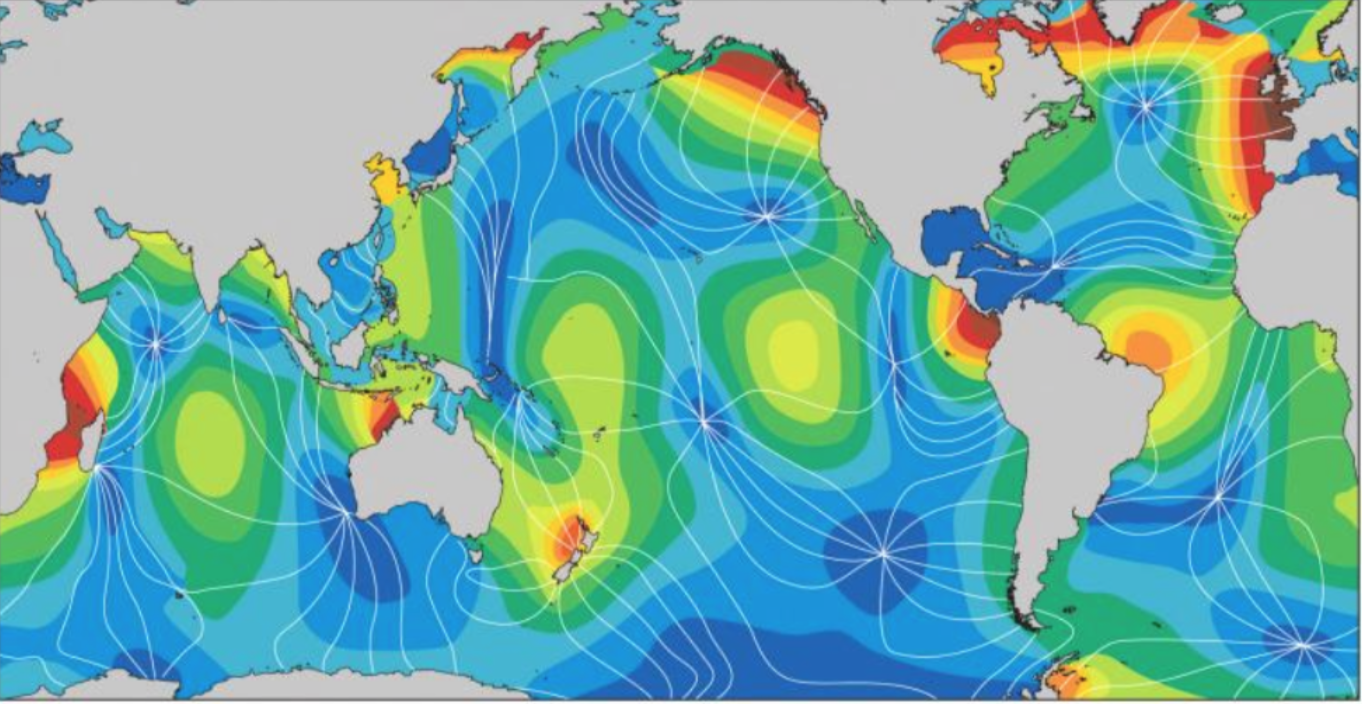
The dark blue points with rotary white lines are amphidromic points—learn about those below. Also, see all that darkred around Europe? Part of that was explained above, but there’s more to it—again, see below. Figure: Tom Garrison, 2014
Before we can understand this, we need to understand a little more about the actual way that tides move around our ocean basins.
You’ve probably heard of the Coriolis effect. In simple terms, it explains why a moving object seems to veer toward the right in the Northern hemisphere and left in the Southern hemisphere (with respect to the direction of travel).
And this effect happens to apply to the tides.
Now, we recall that our landmasses serve as solid boundaries—the liquid tidal bulges can’t pass through them.
“When you combine the Coriolis effect with the ways that our continents place boundaries on where the tides can flow, the result is that tides basically rotate around our ocean basins similar to the way your coffee moves around the perimeter of your cup if you swirl it,” said Kai.
And the coffee cup example is actually quite helpful, because it illustrates the next point as well.
“If you look closely at your coffee—and if you swirl it carefully—you’ll be able to see a wave traveling around the edge of your cup, and you might be able to see that there’s a location near the middle that doesn’t change much in height. That location is the amphidromic point of your coffee wave,” Kai explained.
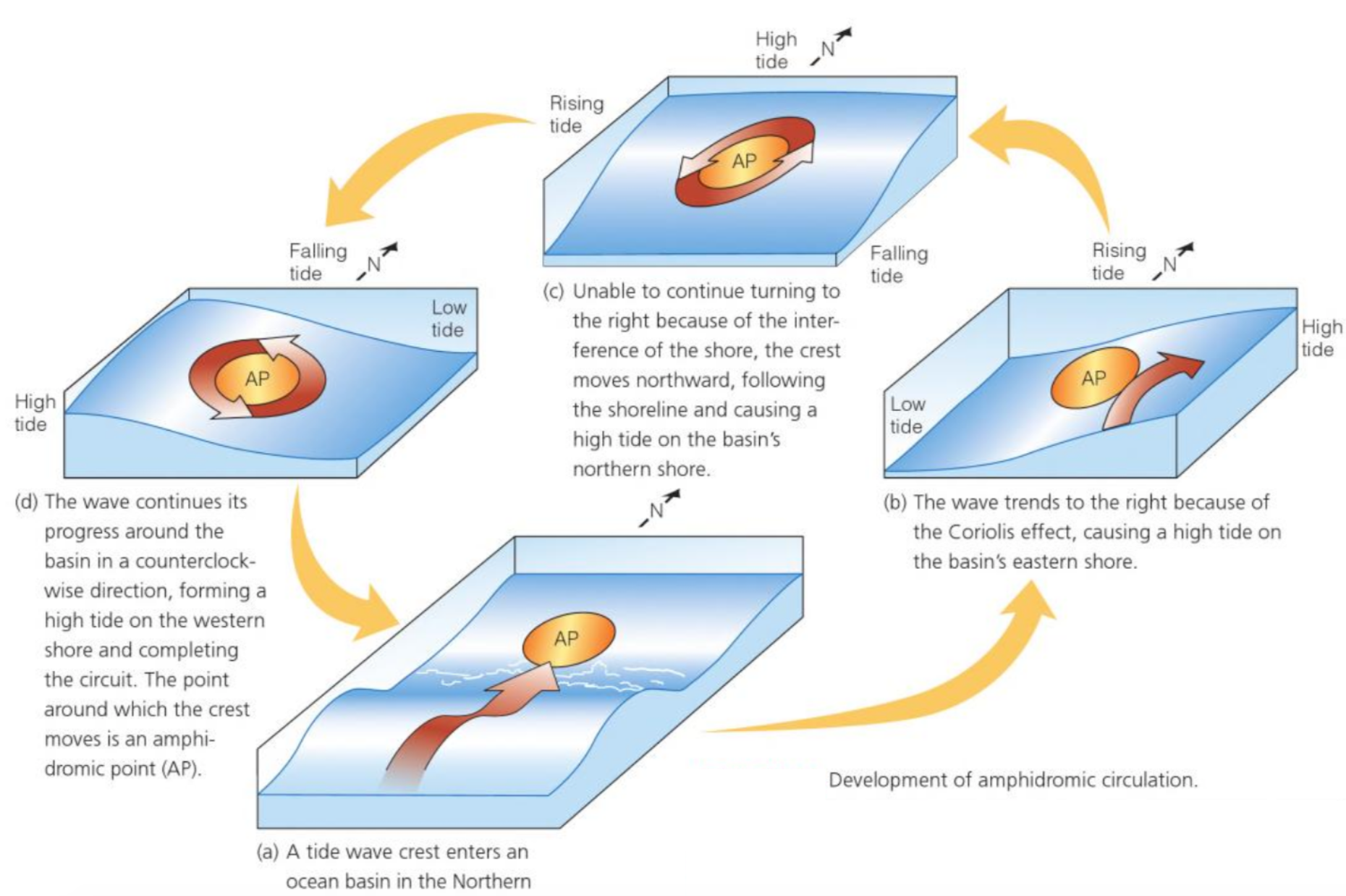
Simplified schematic of how an amphidromic system forms. Figure: Tom Garrison, 2014
“But the shapes of all our continents and islands are complex and completely irregular—so the locations of the amphidromic points are irregular as well. And in the larger ocean basins, you can end up getting multiple amphidromic points instead of just one,” said Kai.
For example, take a look at the Pacific in the map above—you’ll see five dark blue amphidromic points (one being near Hawaii), and they’re neither smack-dab in the center of the ocean nor regularly spaced. There are roughly a dozen total across the globe.
“The end result is that you have these amphidromic points throughout the oceans where the tides are really small, and the tide waves sweep around these points in a rotating manner. In general, the height of the tides increases with distance from these amphidromes, so you’ll have small tidal swings near these points and much larger tidal swings far away from them,” explained Kai.
Recap (errrrr, TLDR?):
In simplified terms, the tidal range at a given location is generally affected by these three main factors:
1) Shape of the coastline — Bays constrict the volume of water in an approaching tidal bulge, which can result in a funneling effect. Also, specific sizes and shapes of bays can lead to tidal resonance. Both of these mechanisms amplify the height of the tides.
2) Continental shelf configuration — Wide and shallow continental shelves have the potential to grow the tides via wave shoaling. Places without a continental shelf (such as islands) or places with a narrow, quickly-deepening shelf don’t have this same potential for tidal amplification.
3) Proximity to amphidromic points — Amphidromic points, which are generally out in the open ocean far away from the continents, are locations where there is nearly zero tidal variation. The tidal range tends to increase with increasing distance from these points.
Putting everything together for our examples:
The Hawaiian islands lack a continental shelf, they lack sufficiently large bays, and they are out in the open ocean near an amphidromic point. On the other hand, places like Europe and north-western Australia have shallow continental shelves, large bays, and they are greater distances from amphidromic points.
When we combine all these factors, we can now understand why Hawaii has such small tide swings, while other places like Europe and north-Western Australia can see such significant tidal extremes.
Do you have a burning question about how the ocean works? Hit us in the comments and we’ll get Dr. Kai to explain it in a future story.














Comments
Comments are a Stab Premium feature. Gotta join to talk shop.
Already a member? Sign In
Want to join? Sign Up